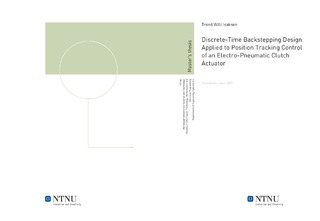Discrete-Time Backstepping Design Applied to Position Tracking Control of an Electro-Pneumatic Clutch Actuator
Master thesis
Permanent lenke
http://hdl.handle.net/11250/259628Utgivelsesdato
2007Metadata
Vis full innførselSamlinger
Sammendrag
This thesis investigates different methods of backstepping controller design for an electro-pneumatic clutch actuator used in heavy duty trucks. The first part of the thesis is a literature study, where the subject is control of nonlinear-sampled data systems in general. Sampled-data systems contain a continuous-time plant and a digitally implemented controller, which in general make them harder to analyze and control than systems that operate purely in the continuous-time or discrete-time domain. The available theory of nonlinear sampled-data control systems is scarce, but three different methods are described in this thesis; emulation design, direct discrete-time design, and sampled-data design. The electro-pneumatic clutch actuator is controlled using a continuous-time backstepping controller implemented digitally. This is essentially the procedure of emulation design and is the common, if not only, method used in practical engineering tasks so far. However, redesign of the continuous-time controller using the direct discrete-time method shows great potential of improving performance and robustness of sampled-data systems. Direct discrete-time design is based on an approximate discrete-time model of the plant, giving the controller a structure that accounts for the sampling of the hybrid system. Potentially, one can utilize slower sampling in the system by implementing a discrete-time controller into the digial computer instead of a continuous-time one. Examples and case studies that prove the improvement one can achieve by chosing the direct discrete-time design is included in the first part of the thesis. Both a third- and fifth-order model of the electro-pneumatic clutch actuator are presented, and used as a basis for continuous- and discrete-time state-feedback backstepping controllers. These controllers are simulated with different sampling intervals to show their performance under different circumstances. The continuous-time controllers prove good reference trajectory tracking of the pure continuous-time system, while the performance of the sampled-data systems descends as higher sampling intervals are used. And, as opposed to the mentioned examples and case studies, the controller designed when taking the sampling into account shows no sign to outperform the controller that was designed without considering the sampling, at least not for the relative fast sampling the clutch actuator operates with.
